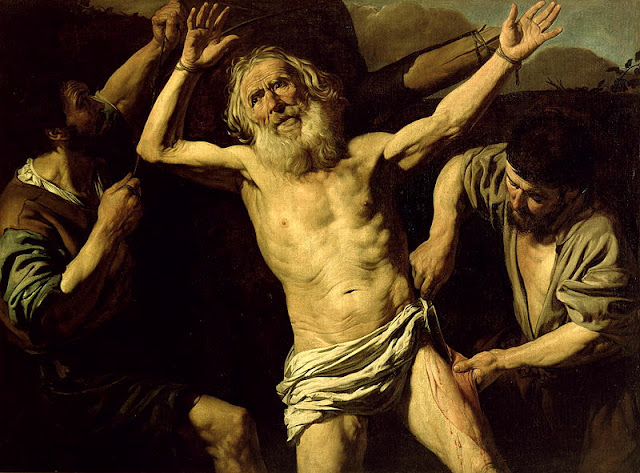I
stumbled across the writer Guy Vaes’ 1978 photography book ‘Les cimetières de Londres’
by complete fluke when I was recently researching the Victorian architect
Thomas Willson. Vaes mentions Willson in passing in the introductory essay to
his book and as luck would have it, that essay was translated and made
available on line last year; a few google searches were enough to make the tenuous
connection between Willson and Vaes and alert me to the existence of his book.
A couple more searches and I had located the one copy of it currently on sale
in the UK. Given the current Euro/Pound exchange rate I could have got a
slightly cheaper version from Belgium or France but as we all need to start
getting used to living without the rest of Europe I paid the Brexit premium and
stumped up for the British one.

My
French is non-existent and I am fortunate that 3 of Vaes’ essays, including his
London cemeteries piece, have been recently translated by Philip Mosely for Literary Geographies, an open access
e-journal. Although he wrote in French, Vaes
was born in 1927 in Antwerp in Flemish speaking Belgium, into a petit bourgeois
family. He spent his childhood reading Jules Verne, HG Wells and Robert Louis
Stevenson and his adolescence, during exile in France and the Nazi occupation
of Belgium, devouring Woolf, Kafka, Melville and Faulkner. After the end of the
war he was determined to become a writer but found himself enlisted in the
Belgian army. An extended period of sick leave due to blood poisoning gave him
the time he needed to start writing his first novel, Octobre long dimanche. This rather slim volume took him ten years
to complete and wasn’t published until 1959. His second took him even longer - L'Envers wasn’t published until 1983. In
retirement he became relatively prolific, publishing his final four novels in a
late burst of creativity between 1993 and 2002. In the long fallow period
between novels he earned his living in journalism, first in Antwerp for 'Le
Matin' and 'La Métropole', and then for the Brussels weekly 'Spécial' where he
became a respected film critic. In 1997 he was elected a member of the Académie
royale de Langue et de Littérature françaises de Belgique. He died in 2012 at
the age of 85 and despite his love of cemeteries, was cremated.
 |
| Kensal Green |
What
is most immediately striking about the introduction to ‘Les cimetières de
Londres’ is the appalling prose style. Passages like the
following are as impenetrable as a schizophrenic's word salad:
At Highgate Hill,
the most inspired of all these entrenchments, the osmosis between the tombs and
the vegetation is that of the Amazonian tribe and its branchy site. As opposed
to the strategist who established his bridgeheads on solid ground, the dead, having
become prior to the Creation, find their feet only on the sloping parts of our
consciousness. That’s to say, in the flaccid, in the marshy, and in that
abyssal which has, however, less thickness than a reflection and whose nerves
transmit the shock waves.
And
what are we supposed to make of Vaes musings on ‘Elegy in a Country Churchyard’?;
“Thomas Gray breathes some air into the
rural literary landscape. He matches his innocent timbre to the sound of a life
that the clay drinks up. To the epitaph transformed into runes, he associates a
fate as discreet as that of a mole.” Sometimes
though the overblown metaphors somehow manage to be genuinely evocative, “similar to the Indians, who breathlessly
prepare to race down the hillside to attack the stagecoach, the graves of old
St. James prepare the attack on London of the living….”
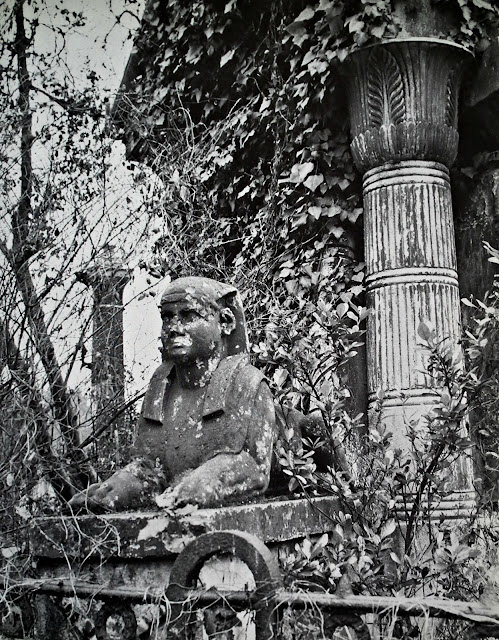 |
| The Ducrow Mausoleum in Kensal Green looking very overgrown |
This
so often reads like a foreign language translated into English by a non native
speaker with a literature degree and a well thumbed thesaurus that it is
tempting to blame the excesses of Vaes style on the translator. But Philip
Mosley is Professor of English and Comparative Literature at Pennsylvania State
University. He has won prizes and decent reviews for his translations of Vaes,
Rodenbach and Maeterlinck. He has published numerous articles in learned journals. He is the editor of ‘Anthracite! An Anthology of
Pennsylvania Coal Region Drama.’ Surely if anyone should be able to string a coherent,
grammatical sentence together it is a professor of English? Which means that if
the English of Mosley’s translation is impenetrable it is because so is the
French of Vaes’ original. At first I found it difficult to believe that a published novelist could
write quite so badly but after a few pages I found Vaes’ overblown style beginning
to exert something akin to fascination:
We hardly dare,
for fear that the stretched imagination will boil over, to picture London as
dreamed up by Jeremy Bentham, that Oxonian whose embalmed body, clothed as an
eighteenth-century squire, is preserved in a cabinet at the University of London.
His big idea was embalming. Bury the stiffs? What sacrilege! He wished to see Londoners
mummified so as to render them as decorative objects. One would thus have kept
mother and father in the drawing-room, installed grandfather in the bedroom, seated
grandmother on the balcony, and grouped the ancestors beneath the foliage of a square.
Bentham elaborated on it in Auto-Icon, or Further Uses of the Dead to the
Living. Thanks to him, London would have become the huge appendix of Madame
Tussaud. We would have mingled—at the Café Royal or in a box at the Palladium,
beneath an awning in Covent Garden or in the corridors of the Underground—with
people in moth-eaten ruffles and with extremely creased cheeks. We would have
been seated beside them in a first-class train car or on the upper deck of an
omnibus; and the equinoctial winds would have dispersed that threatening dust,
unless a refuse collector’s shovel ….
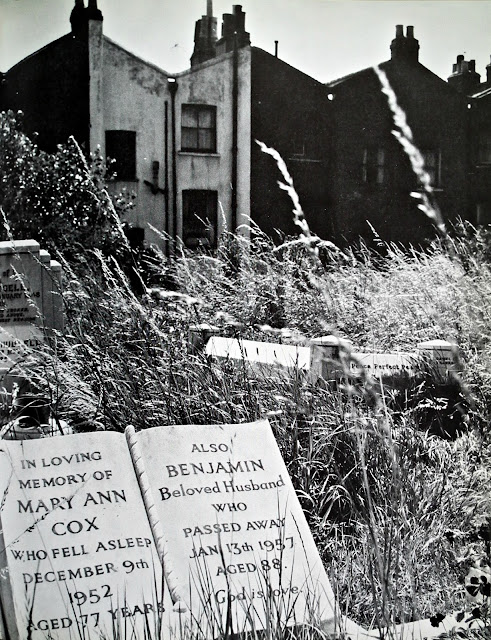 |
| Highgate |
There
is something infectious about Vaes’ enthusiasm for his subject. His epigraph to
the book is “the cemeteries of London ….
Those four words have always had the effect on me that Christopher Columbus’s
crew must have felt, at the end of an anxious voyage, when the look-out shouted
‘Land!’” He was remarkably well informed about the history of London’s
dead. He walks us though, in his own inimitable way, the history of the
cemetery movement in the capital, he talks about the key figures involved (indeed
he dedicates the book to his wife Lydia and Stephen Geary, dead more than a
century even in the 1970’s, the eccentric architect who designed many of the
best loved features of Highgate, founder member of the General Cemetery Company
and tireless campaigner for burial reform) and knowledgeably discusses the
Victorian background. He mentions not only Thomas Willson, the proposer of the
Pyramid mausoleum, and Hume’s auto-icon but Enon Chapel, Ducrow, Hawksmoor, Brompton,
Nunhead, Tower Hamlets, City of London Cemetery, St Olaves, St
Bartholomew-the-Great, George Alfred Walker, The Duke of Portland (albeit he
calls him the Duke of Portman) and T.C. Druce, William Haywood and Arthur Machen. All of this makes him seem remarkably up to date.
Was anyone else writing about all this in the 1970’s? (Except perhaps James
Steven Curl, who was another man ahead of his time).
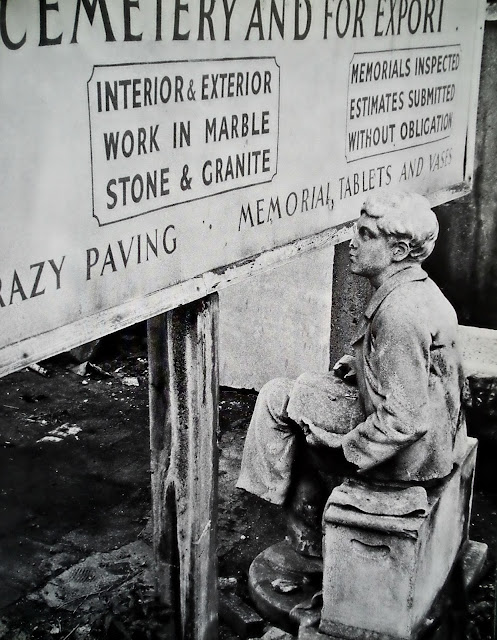 |
| Kensal Green - Landers? |
Unlike
his prose, Vaes photographs are artfully but simply composed. Taken in the mid 1970’s
they reveal some surprises like the peacocks that apparently used to live in
Highgate Cemetery or the original Limehouse premises of the Wanstead funeral
directors Francis & Chris Walters. My favourite picture is the cover shot (thankfully
included inside free of lettering) of a one handed Kensal Green Angel with the
gas works steaming away in the background. Another shot shows the Ducrow
mausoleum overgrown with ivy, something you would like to believe that would
not be allowed to happen today. In other ways the monochrome images are
timeless – most of the locations are instantly recognisable. In his foreword Vaes discuses other cemeteries where he must have taken pictures but which don't appear as images in his book. Pictures that are probably lost for ever now.
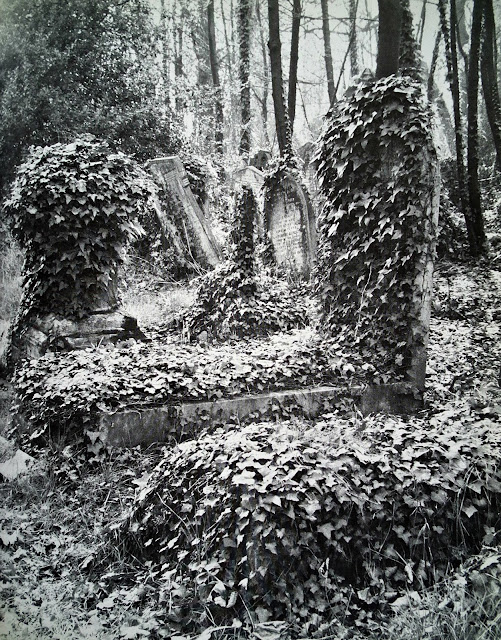 |
| Nunhead |
“Even more
radical is the negative transformation undergone, since 1969, by Nunhead, Bunning’s
masterpiece shining on the south bank of the Thames. Yews, oaks, and tulip trees
have been transformed there into cones of ivy. The Dissidents’ Chapel has been destroyed
a few steps from the Anglican Chapel, that exquisite Gothic paraphrase by Thomas
Little, who designed St. Saviour at Paddington, …….. But nothing equals in
beauty the lyricism of a ground which, swelling like a wave, goes forth on its
own conquest, falls back, subsides and, reforming its tidal wave of clover and
horsetail, raises crosses and statues higher than the adjacent chimney stacks.”
 |
| The circle of Lebanon, Highgate Cemetery |
“Up to where the
Columbarium, anticipated and called for by the presentiment of a focal point,
announces itself. With its rounded pillars of gangrened drums, the leprous obelisks
that solemnize its gap, the Egyptian gate, at least its image on the retina,
has the power of a geyser’s source. It surges forth, tremendous in its
peculiarity, stormy in its mass, from that which has reclad the view of a
valley and was formerly a bare path. Beyond the grilles, with the freshness of
a subterranean river, the Egyptian avenue and its tombs present themselves.
Each verdigris door, stuck fast to a frame that has split, is equipped with a
metal handle that the arm can no longer succeed in lifting. And, at the end of
this funeral opening, a cedar, divinity with fan of arms blackened by
blowtorch, besets a triangle of sky above a fresh succession of tombs. Beneath
the spreading branches of this tree out of a sculptor’s studio, an alley whispers
in the form of a ring, the Circle of Lebanon. There the Egyptian Avenue ends.
Metal doors, marked by rust-filled craters, oscillated by an inventive
dampness, have confined their occupiers to cells in the thickness of those
concentric walls. And everywhere, from top to bottom, on the two flights of
steps leading to the next to last terrace, holly, umbellifers, horsetails by
the thousand, the pale mauve of the columbine, and a number of other plants
whose names escape me.”
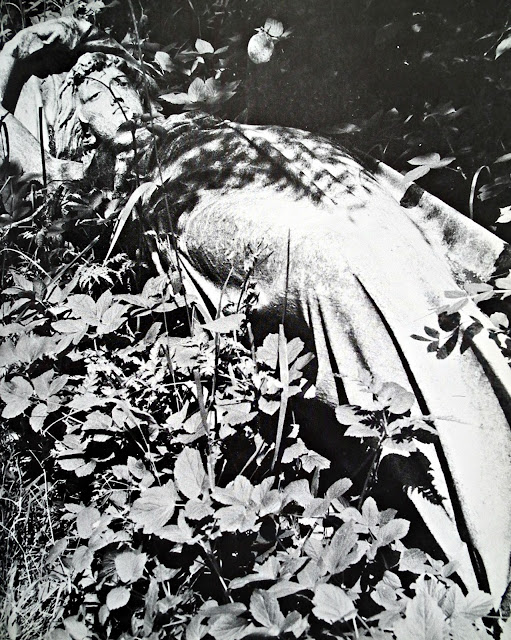 |
| Highgate |
“…a stone angel, felled by
leather jacketed goliaths of Peckham, lies in the grass like a peasant-girl
after an act of love. She imitates the pose and shares the fate of a
fascinating statue of a woman, removed from its plinth, in the modern section
of Highgate. It happens occasionally—the sound has stayed in my ears—that a
huge branch of a tree breaks off with the crack of a hull ramming a reef.”
 |
| Francis & Chris Walters Undertakers, Limehouse |
 |
| St Anne's, Limehouse |
“Among
these overly unassuming parcels of land one may still choose St. Anne in
Limehouse. The church, one of the three largest and most accomplished by
Hawksmoor, faces a pyramidal tomb of Portland stone.”
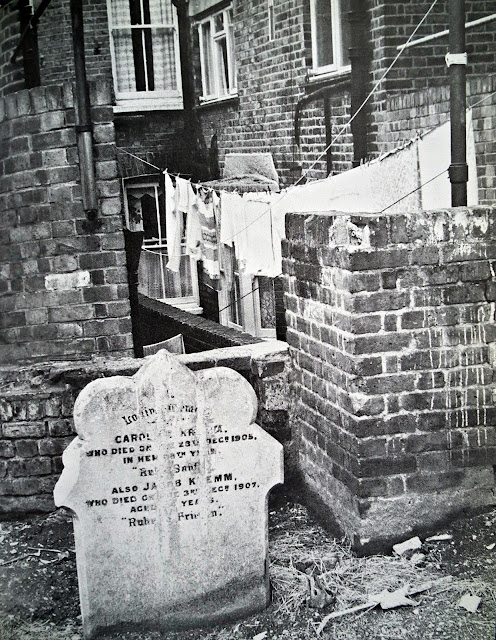 |
| Tower Hamlets Cemetery |
Vaes discusses one of the great legends of the London Dead, the exhumation of Elizabeth Siddall by Dante Gabriel Rossetti. For anyone not aware of the story, the distraught poet placed a sheaf of love poems (the only copy) in her coffin when his beloved model, muse and wife Lizzie died of a laudanum overdose and was buried at Highgate. Seven years later, a hopeless drug and alcohol abuser, convinced he was going blind and facing penury Rossetti had Lizzie exhumed in order to retrieve the poems and publish them. The story goes that Lizzie’s hair had continued to grow for the entire seven years following her death and was “an interminable golden banner waved in the evening breeze just beyond an inexpressible face. That hair covered the remains from head to foot” as Vaes puts it. It is a story heard in many countries and cultures - “The stone shattered at the first blow of the pick-axe and a stream of living hair the intense colour of copper spilled out of the crypt. The foreman, with the help of the labourers, attempted to uncover all the hair, and the more of it they brought out, the longer and more abundant it seemed, until at last the final strands appeared still attached to the skull of the girl…” Garcia Marquez ‘Of Love and Other Demons’
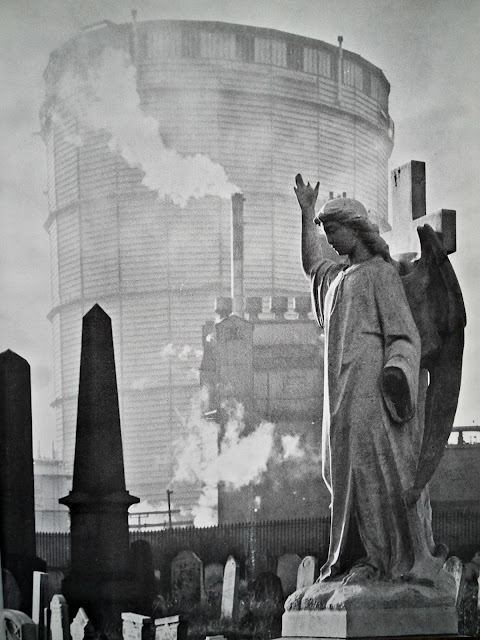 |
| Kensal Green |






























